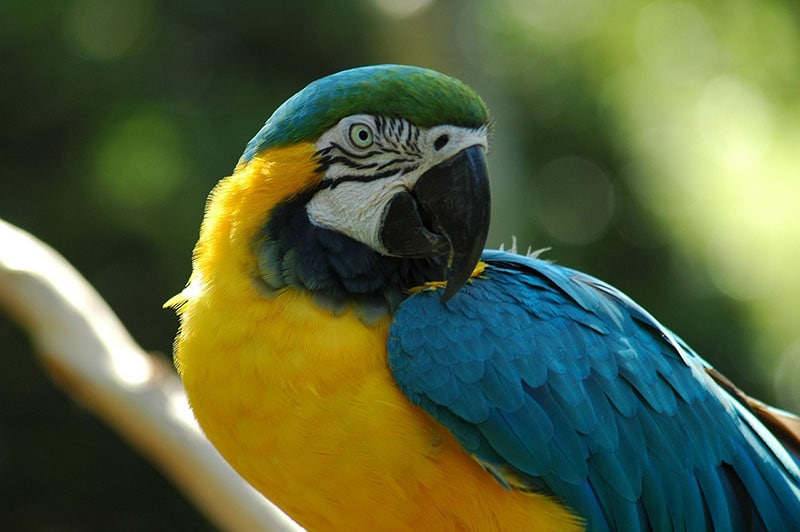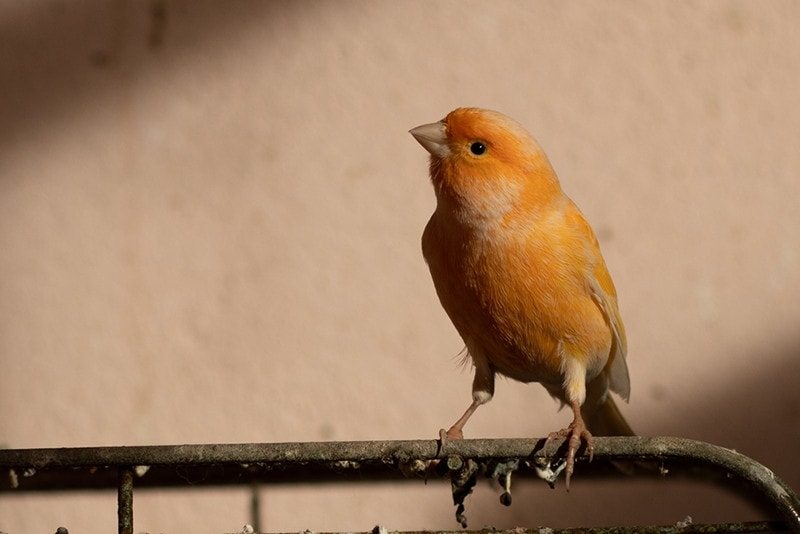Yellow-Chevroned Parakeet: Pictures, Personality, Food & Care Guide
Updated on

Click to Skip Ahead
The yellow-chevroned parakeet (Brotogeris chiriri) is a species of parakeet found in tropical regions of South America. While they aren’t the most commonly kept parakeet species by any stretch of the imagination, they can make great pets for people well-versed in the world of birdkeeping.
Read on to learn more about this beautiful species to see if this bird will suit your skill level and lifestyle.
Species Overview
| Color: | Shades of green and yellow |
| Size: | 20–25 cm |
| Weight: | 65–70 grams |
| Wingspan: | 30 cm |
The yellow-chevroned parakeet is part of the Brotogeris genus of small parrots endemic to South and Central America. Brotogeris translates to “having the voice of a human,” though the yellow-chevroned parakeet isn’t particularly known for its speaking abilities; it can learn to mimic some sounds and words.
Yellow-Chevroned Parakeet Characteristics
History & Natural Habitat
The yellow-chevroned parakeet is found mostly in tropical South America. They’re found in areas south of the Amazon River basin and countries like southern Bolivia and Brazil and northwestern Argentina. They prefer habitats like forests, savannas, open woodlands, and parks.
 Things to Know When Owning a Yellow-Chevroned Parakeet
Things to Know When Owning a Yellow-Chevroned Parakeet

Temperament
Birds of the Brotogeris family, such as the yellow-chevroned parakeet, tend to be smart, curious, and energetic. They’re highly sought after as pets for their playfulness and sweet personalities; however, building a relationship and gaining their trust is easier if they are introduced into the family unit already hand-fed and properly socialized. That’s not to say it is entirely impossible to keep a yellow-chevroned parakeet that hasn’t been hand-fed, but it will take some time and patience.
These birds are bold and fearless, which can get them into trouble if they’re left alone to their own devices for too long. This is why we recommend never leaving your parakeet unattended for outside-of-the-cage time, as their inquisitive nature may cause injuries or accidents.
Yellow-chevroned parakeets may be stubborn and demanding. They can even throw temper tantrums if they don’t get their way, so you must be firm when training them.
Sounds, Speech & Vocalizations
Yellow-chevroned parakeets are not particularly known for their talking ability, though they can learn to mimic some sounds and words. They can also learn how to whistle and are considered a medium-noisy parrot species. They make a loud, high-pitched, chattering call, though they are also known to make loud squawks at times.
Yellow-Chevroned Parakeet Appearance
The yellow-chevroned parakeet is a small bird, measuring around eight to nine inches in length. They are slightly larger than their closely related cousins, the greycheek and the lovebird. You cannot tell a male and female apart by looking at them, so sexing them is only possible via surgery or using DNA.
Despite its name suggesting a different main color, the yellow-chevroned parakeet’s plumage is predominantly bright green. The underparts are slightly paler green, while the underwing area has a yellow-green tinge. Their wings are darker green, with a yellow edge visible when the wings are folded. You can also see this trailing yellow edging when the bird is in flight.
These birds have orange-brown hook-shaped beaks and pink-grey feet.
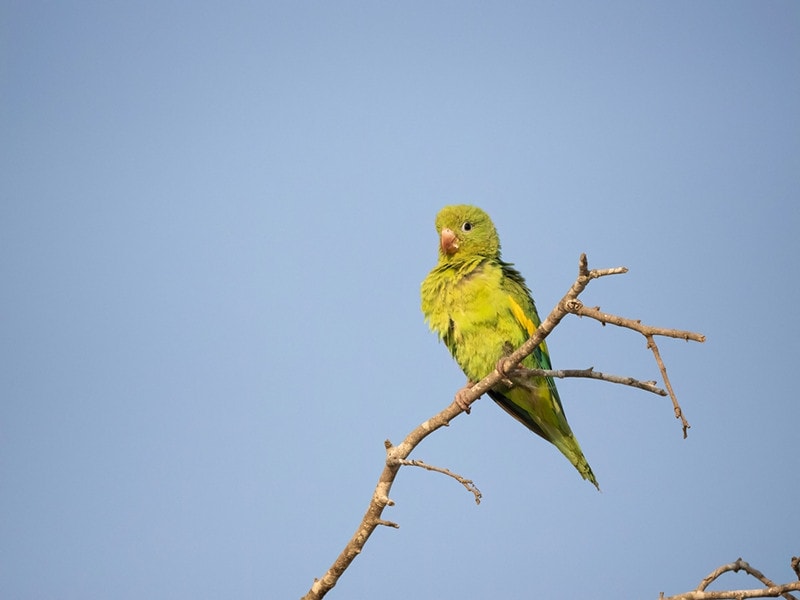
Caring for the Yellow-Chevroned Parakeet
While this is certainly not the most common parakeet species to be kept as pets, caring for the yellow-chevroned parakeet is not at all unlike caring for other birds in the species. They’re typically much easier to care for than their larger parrot counterparts and will require much less space than, say, a Macaw. That’s not to say you can skimp out on the cage, however, as they still need a fair amount of space to stay happy and healthy.
Parakeets are social birds that typically thrive when kept in pairs. They can keep one another busy and entertained, ensuring both birds are physically and mentally stimulated. However, it is important to consider your bird’s gender when determining their suitability for a cage mate. Most experts do not recommend housing two females together as they are more aggressive than their male counterparts and can get into fights. Keeping two males in the same cage is a much better option, as they generally get along fine and are okay with sharing. If you prefer to keep your yellow-chevroned parakeet alone, know that you’ll need to step up and spend a lot of time with them to keep them happy.
Before adopting any companion bird, we highly recommend educating yourself on common household dangers that take the lives of many pet birds every year. Teflon is one of the biggest problems you should know about. Teflon is a brand name for a chemical coating called polytetrafluoroethylene (PTFE). When Teflon is heated, it releases an airborne toxin that can instantly kill your bird. To complicate things, Teflon and other similar PTFE-based non-stick coatings can be found in many household products aside from frying pans, including, but not limited to, drip pans, heat lamp covers, irons, ironing board covers, self-cleaning ovens, pizza boxes, air fryers, hair straighteners, light bulbs, etc.
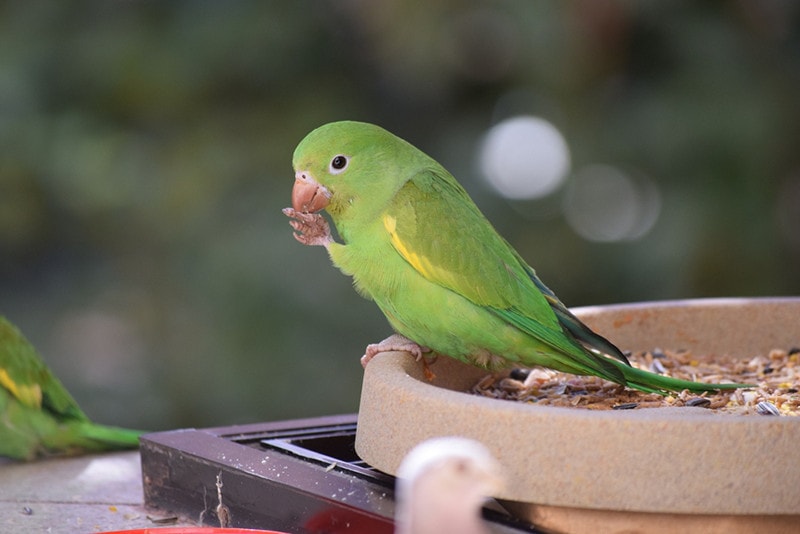
Diet & Nutrition
Wild yellow-chevroned parakeets survive mostly on seeds and fruits. Feral populations, however, have adapted to a diet that consists also of blossom and nectar. Dryer periods in the wild cause fruit scarcity, so these birds can adjust their diets to this situation by eating more seeds, particularly those from the Erythrina dominguezii commonly found in the deciduous and semi-deciduous forests in western Brazil.
As pets, these birds will require a diet much the same as any other parakeet species. It should consist primarily of commercially produced pellets, with fresh produce comprising around 20% of the diet.
Cage/Housing Requirements
Yellow-chevroned parakeets, like other companion birds, require a larger cage than you might think. Your bird will need a spacious enclosure for them to stretch their wings when their perches, toys, food bowls, and other accessories have been installed. Generally speaking, the bigger the cage you can provide, the better.
The cage you buy should have both horizontal and vertical bars so your parakeet can climb and get around the cage more easily. Bar spacing should be considered as cages with spaces either too far apart or too close together can pose significant hazards as your pets may get their heads or feet stuck.
Exercise
Yellow-chevroned parakeets need to have plenty of outside-the-cage time to remain happy and healthy. A bird that’s kept cooped up in their cage for too long can turn to destructive behaviors, such as feather plucking, as a way to pass the time. You should, at minimum, allow your bird an hour or two of supervised time outside their cage daily. The more time you can provide them outside of the cage, the better.
Since these birds are highly active and love to play, they require many different types of bird toys to stave off boredom. They can entertain themselves for hours with the right toys, so you may need to do some trial and error to find which type your bird prefers.

Health & Conditions
The yellow-chevroned parakeet is at risk of developing the same health conditions as other parakeets.
Parakeets commonly develop cancerous tumors in the kidneys and reproductive organs. These tumors may sometimes cause unilateral lameness, where it appears as if your parakeet has an injured leg.
They can also suffer from hypothyroidism, especially when fed a poor-quality diet, such as one that consists only of seeds. Poor diets can also cause obesity and hepatic lipidosis, which often causes premature death. Parakeets fed an all-seed, high-fat diet may also develop tumors such as lipomas or xanthomas.
Parakeets may be at risk of psittacosis or parrot fever. This is especially true if they’ve been kept in close contact with other birds, such as when they’re housed together in pet stores. Parrot fever can be carried by parakeets even if they don’t display clinical signs. Those infected may show signs such as sneezing, difficulty breathing, and a decreased ability to fly.
Parakeets can be susceptible to external parasites such as scaly face mites or skin and feather mites. If left untreated, it can spread to you and may even cause serious illness or death for your bird.
Feather plucking is a behavioral issue some parakeets may resort to. This behavior is relatively common in pet birds and can be caused by a host of factors, including an improper diet, boredom, or health conditions like tumors.
- Feather plucking
- Cancer
- Hypothyroidism
- Obesity
- Parrot Fever
- Tumors
- Mites
3 Little-Known Facts About the Yellow Parakeet
1. Some self-sustaining populations of the yellow-chevroned parakeet exist.
Some caged yellow-chevroned parakeets have been released in some areas, resulting in these escapees having established their own self-sustaining populations. You can find these birds in places like Miami, San Francisco, and Los Angeles. There may also be populations of released or escaped yellow-chevroned parakeets throughout New York and Connecticut.
2. They were, at one time, the most commonly imported parrot.
There was a period between the late 60s and mid-70s when the yellow-chevroned parakeet was the most commonly imported parrot species. During this time, over 260,000 of these birds were imported from South America specifically for the pet trade.
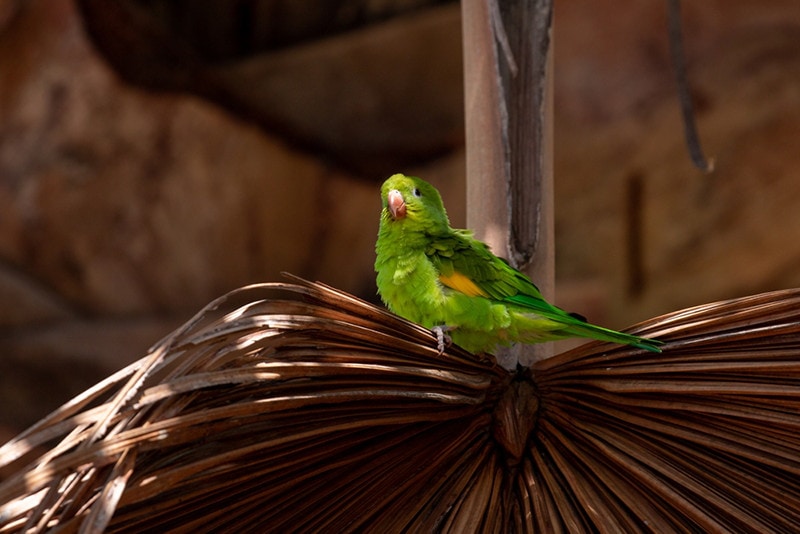
3. There was once some confusion regarding the yellow-chevroned parakeet and the canary-winged parakeet.
The yellow-chevroned parakeet is very closely related to the canary-winged parakeet. They are so closely related, in fact, that they were once considered a subspecies. Recently, canary-winged parakeets were separated into two separate species (the white-winged parakeet and the yellow-chevroned parakeet) to try to eliminate some of the confusion, as many pet stores were improperly specified birds. Though the chevroned species has the same yellow covert feathers as seen in the canary parakeet, they do not have the white primary feathers seen on the wing in the latter.
Conclusion
Though the yellow-chevroned parakeet is not the most commonly kept parakeet species, they can make the perfect pet for the right family. We recommend doing research before welcoming any bird into your home, as their needs are very different from cats and dogs. Familiarize yourself with common household dangers (like Teflon) and make the necessary lifestyle changes before your new parakeet comes home with you.
Featured Image Credit: Vinicius R. Souza, Shutterstock


